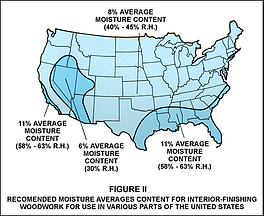Posted by Tom Laurenzi on Aug 28, 2015 3:46:00 PM
As a flooring contractor or a restoration specialist, you know that flooring installation can become a tough task with all of the protocols and safety precautions that you have to keep in mind. However, when you’ve finished a project, your clients will be appreciative and have new ground to call their own. One of the tools that’s necessary to ensure a sound structure and overall successful project is a moisture meter.
Moisture meters help to prevent call-backs to make sure your project is done correctly the first time. Furthermore, it gives both you and your customer the peace of mind that comes with knowing that your work is verified by a trustworthy device.
In this post, we’ll get into common flooring mishaps and how moisture meters can serve as the helpful tool you need to prevent them.
 Improper Wood Acclimation
Improper Wood AcclimationBefore wood is shipped or installed, it must be acclimated to the region or environment where it will be placed. As areas of the United States have different relative humidity (anywhere from 30-63%), the moisture levels of the wood have to be at a specific point as to not bleed or absorb unnecessary amounts of moisture to reach EMC (equilibrium moisture content).
If it does shed too much moisture, then the floor beneath the surface (typically concrete) can buckle, warp, or otherwise become deformed.
Instead, restoration specialists or contractors should make use of a wood moisture meter to guarantee the moisture content (%MC) is at its optimum level. As a rule of thumb, one should check the moisture of the wood once it’s received from the distributor, before shipping, when it arrives to the job site, during acclimation, before installation, and after installation.
In addition to measuring moisture, relative humidity is a factor that must also be accounted for when installing wood floors. The moisture content of the wood must be kept at certain levels to ensure a proper installation and a long-lasting floor.
There’s always a designated limit for the relative humidity, hence the importance of meters that are able to measure relative humidity. Thermo-hygrometers such as the Delmhorst HT-4000F or the Navigator Pro 3-in-1 are meters that can do the job.
When floods cause damage to homes or businesses, the flooring is completely covered in water and can be difficult to restore. Professionals have to determine the wettest areas first and then focus on then focus on that region.
Moisture meters help expedite the process and allow restoration specialists to pinpoint the spots that require the most urgent work.
Being able to prioritize work gives moisture meter users the advantage of saving countless hours, labor and money when servicing their customers’ damaged buildings.
Remember, unchecked moisture can lead to costly consequences in flooring installations including insurance claims, lost time, dwindling profits and expensive call-backs. Making sure your restoration or contracting team is well-equipped with a moisture meter that can measure both moisture and relative humidity is a huge step in the right direction to ensure peace of mind with your clients and to guarantee a smooth project.
For more information on which moisture meter is right for your next project, please feel free to enlist the help of one of our specialists today!

Moisture Meters
Support
Copyright © 2025 Delmhorst Instrument Co.
Comments